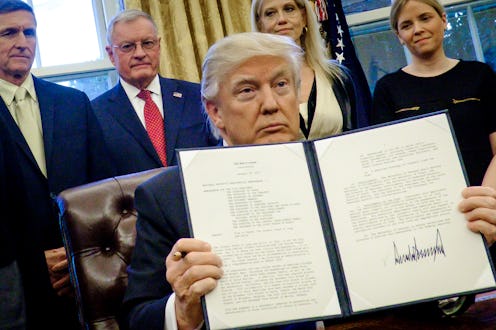News
How An Executive Order Could Be Repealed

In some of his first presidential actions, Donald Trump has signed many executive orders since his inauguration on Jan. 20. They are being fiercely challenged in both the courts and the streets. They have even already been modified. Although he holds the highest elected position in the U.S. government, Trump is not all-powerful, and his executive orders can be overturned and revoked. The power lies with Congress, the Supreme Courts, and future presidents.
As the Congressional Research Service reports, Congress has the power to repeal executive orders through legislation, though it merely redefines the executive orders as "having no legal effect." Another option is to undermine an executive order by targeting their sources of funding. But both options require majority votes, and who knows how possible enacting such legislation is with a majority Republican House and Senate, especially considering the number of GOP congresspeople who are in favor of, neutral, or haven't released comment on the immigration order.
Executive orders derive their powers from the Constitution and are subject to review by the Supreme Court. If the Court finds that the order violates the Constitution, they can overturn it. That's what happened in 1952, when SCOTUS struck down Harry Truman's executive order that the federal government take control of much of the country's steel mills. And that's what many legal advocates, including the ACLU, are fighting to make sure happens with Trump.
Lastly, presidents can use their own executive orders to revoke those signed by previous presidents. In fact, Barack Obama is one of the presidents to have exercised this right, and as the Pew Research Center notes, he did so 30 times. In 2009, Executive Order 13497 revoked George W. Bush's Executive Orders 13258 and 13422, both concerning the regulatory review process. But, of course, Trump's presidency has just started.
The voices of the American people help put pressure on elected officials to represent their interests when supporting or opposing executive orders. Trump has already made his move by signing his orders, and he doesn't have a track record when it comes to taking things back. But no matter how representatives and senators may personally feel about Trump's orders, it is their duty to act on behalf of their constituents.
When it comes to repealing Trump's executive orders, the good news is that spontaneous demonstrations and being flooded with phone calls are catching elected officials' attentions. A sustained resistance effort will make sure they can't look away.